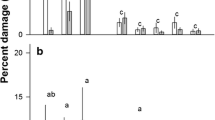Abstract
Because of their potential as antiherbivore defenses, plant phenolics elicit considerable attention. We made quantitative and qualitative analyses of phenolics, alkaloids, cyanogenic glycosides, and saponins in the dominant graminoids of a Nebraska Sandhills prairie. We examined the foliage of seven species:Agropyron smithii Rydb.,Andropogon hallii Hack.,Andropogon scoparius Michx.,Bouteloua gracilis (H.B.K) Lag. ex Griffiths,Calamovilfa longifolia (Hook.) Scribn.,Carex heliophila Mack., andStipa comata Trin & Rupr. Their leaves contain low levels of phenolics that vary significantly among species. A more detailed examination of the three species with the highest levels of phenolics showed among-year, seasonal, and spatial heterogeneity in the levels of total phenolics. In all seven species, the majority of the specific phenolics present have the Chromatographic properties of phenylpropanoids and are likely to be present as sugar-linked derivatives such as free glycosides or cell wall-bound phenolics. These species do not contain condensed tannins. The absence of other common kinds of secondary metabolites indicates that these graminoids are unlikely to have significant chemical defenses, at least in terms of substances likely to be active against mammalian herbivores. In this, they exemplify the situation thought typical for prairie graminoids.
Similar content being viewed by others
References
Barnes, P.W., andHarrison, A.T. 1982. Species distribution and community organization in a Nebraska Sandhills mixed prairie as influenced by plant/soil water relationships.Oecologia 52:192–201.
Bryant, J.P., Chapin, F.S., III, andKlein, D.R. 1983. Carbon/nutrient balance of boreal plants in relation to vertebrate herbivory.Oikos 40:357–368.
Burke, I.C., Kittel, T.G.F., Laurenroth, W.K., Snook, P., Yonker, C.M., andParton, W.J. 1991. Regional analysis of the central great plains: sensitivity to climate variability.Bioscience 41:685–692.
Caldwell, M.M. 1981. Plant responses to solar ultraviolet radiation, pp. 170–197,in O.L. Lange, P.S. Nobel, C.B. Osmond and H. Ziegler (eds.). Encyclopaedia of Plant Physiology: Physiological Plant Ecology I. Springer-Verlag, New York.
Chapin, F.S., Shaver, G.R., andKedrowski, R.A. 1986. Environmental controls over carbon and phosphorous fractions inEriophorum vaginatum in Alaskan Tussock Tundra.J. Ecol. 74:167–195.
Corcuera, L. 1989. Indole alkaloids fromPhlaris and other graminae, pp. 123–178,in P.R. Cheeke (ed.). Toxicants of Plant Origin, Vol. I. CRC Press, Boca Raton, Florida.
Darnley-Gibbs, R.D. 1974. Chemotaxonomy of flowering plants. McGill-Queen's University Press, Montreal.
Fahey, G.C., andJung, H.J.G. 1989. Phenolic compounds in forages and fibrous feedstuffs, pp. 123–190,in P.R. Cheeke (ed.). Toxicants of Plant Origin, Vol. IV. CRC Press, Boca Raton, Florida.
Feeny, P.P. 1968. Effect of oak leaf tannin on larval growth of the Winter MothOperoptera brumata.J. Insect Physiol. 14:805–817.
Feigl, F., andAnger, V.A. 1966. Test paper for hydrogen cyanide.Analyst 91:282–285.
French, N.R. 1979. Perspectives in Grassland Ecology. Springer-Verlag, New York.
Gartlan, S.J., McKey, D.B., Waterman, P.G., Mbi, C.N., andStrusaker, T.T. 1980. A comparative study of the phytochemistry of two African rainforests.Biochem. Syst. Ecol. 8:401–422.
Harborne, J.B. 1984. Phytochemical methods: A guide to modern techniques of plant analysis. Chapman and Hall, London.
Harborne, J.B. 1988. Introduction to Ecological Biochemistry. Academic Press, London.
Haskins, F.A., andGorz, H.J. 1988. Independent inheritance of genes for dhurrin and leucoanthocyanidin in a sorghum cross.Crop Sci. 28:864–865.
Hemken, R.W., andBush, L.P. 1989. Toxic alkaloids associated with tall fescue toxicosis, pp. 281–290,in P.R. Cheeke (ed.). Toxicants of Plant Origin, Vol. I. CRC Press, Boca Raton, Florida.
Horner, J.D. 1990. Nonlinear effects of water deficits on foliar tannin concentration.Biochem. Syst. Ecol. 18:211–213.
Janzen, D., andWaterman, P.G. 1984. A seasonal census of phenolics, fibre and alkaloids in foliage of forest trees in Costa Rica: some factors influencing their distribution and relation to host selection by Sphingidae and Saturnidae.Biol. J. Linn. Soc. 21:439–454.
Jonasson, S., Bryant, J.P., Chapin, F.S., III, andAndersson, M. 1986. Plant phenols and nutrients in relation to variations in climate and rodent grazing.Am. Nat. 128:394–408.
Jung, H.-J.G., Batzli, G.O., andSiegler, D.S. 1979. Patterns in the phytochemistry of arctic plants.Biochem. Syst. Ecol. 7:203–209.
Kaul, R.B. 1975. Vegetation of Nebraska (map). Conservation and Survey, Lincoln, Nebraska.
Marks, D.L., Swain, T., Goldstein, S., Richard, A., andLeighton, M. 1988. Chemical correlates of rhesus monkey food choices.J. Chem. Ecol. 14:213–235.
Mauffette, Y., andOechel, W.C. 1989. Seasonal variation in leaf chemistry of the coast live oakQuercus agrifolia and implications for the California oak mothPhryganidia californica.Oecologia 79:439–445.
McNaughton, S.J. 1983. Physiological and ecological implications of herbivory, pp. 270–298,in O.L. Lange, P.S. Nobel, C.B. Osmond, and H. Ziegler (eds.). Encyclopaedia of Plant Physiology: Physiological Plant Ecology III. Springer-Verlag, New York.
Mole, S., Butler, L.G., Hagerman, A.E., andWaterman, P.G. 1989. Ecological tannin assays: A critique.Oecologia 78:93–96.
Mulvena, D.P., andSlaytor, M. 1982. Separation of tryptophan derivatives inPhlaris aquatica by thin layer chromatography.J. Chromatogr. 245:155–161.
Owen, D.F., andWiegert, R.G. 1981. Mutualism between grass and grazers: An evolutionary hypothesis.Oikos 36:376–378.
Price, M.L., andButler, L.G. 1977. Rapid visual estimation and spectrophotometric determination of tannin content of sorghum grain.J. Agric. Food Chem. 25:1268–1273.
Redak, R.A. 1987. Forage quality: Secondary chemistry of grasses, pp. 100–111,in J.L. Carpinera (ed.). Integrated Pest Management on Rangeland: A Shortgrass Prairie Perspective. Westview Press, Boulder, Colorado.
Rhoades, D.F. 1977. Integrated antiherbivore, antidesiccant and ultraviolet screening properties of creosote bush resin.Blochem. Syst. Ecol. 5:281–290.
Rhoades, D.F., andCates, R. 1976. Towards a general theory of plant antiherbivore chemistry.Recent Adv. Phytochem. 10:168–213.
Tempel, M.S. 1981. Field studies of the relationship between herbivore damage and tannin concentration in brackenPteridium aquilinum Kuhn.Oecologia 51:97–106.
Waterman, P.G., andMole, S. 1989. Extrinsic factors influencing production of secondary metabolites in plants, pp. 107–134,in E.A. Bernays (ed.). Plant-Insect Interactions. CRC Press, Boca Raton, Florida.
Waterman, P.G., Choo, G.M., Vedder, A.L., andWatts, D. 1983. Digestibility, digestion inhibitors and nutrients of herbaceous foliage and green stems from an African montane flora and comparison with other tropical flora.Oecologia 60:244–249.
Weaver, J.E. 1965. Native Vegetation of Nebraska. University of Nebraska Press, Lincoln, Nebraska.
Author information
Authors and Affiliations
Rights and permissions
About this article
Cite this article
Mole, S., Joern, A. Foliar phenolics of nebraska sandhills prairie graminoids: Between-years, seasonal, and interspecific variation. J Chem Ecol 19, 1861–1874 (1993). https://doi.org/10.1007/BF00983792
Received:
Accepted:
Issue Date:
DOI: https://doi.org/10.1007/BF00983792




